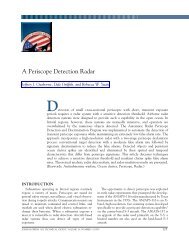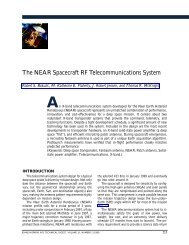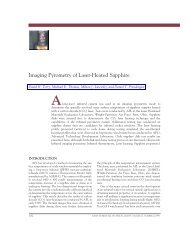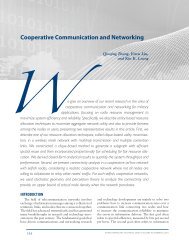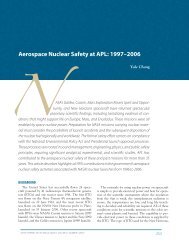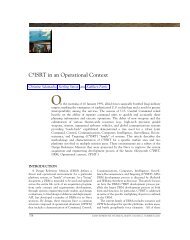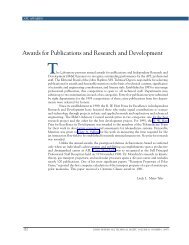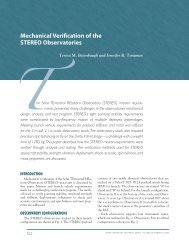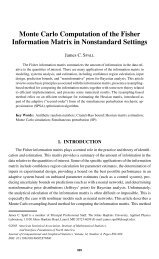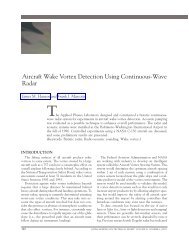Tomahawk Deconfliction - The Johns Hopkins University Applied ...
Tomahawk Deconfliction - The Johns Hopkins University Applied ...
Tomahawk Deconfliction - The Johns Hopkins University Applied ...
You also want an ePaper? Increase the reach of your titles
YUMPU automatically turns print PDFs into web optimized ePapers that Google loves.
A. F. POLLACK, R. C. FERGUSON, AND A. K. CHRYSOSTOMOU<br />
is too small to worry about.” This theory was not based<br />
on formal analysis, but rather on a sense that the navigational<br />
and timing uncertainties of the missile made<br />
collision unlikely. Relatively few <strong>Tomahawk</strong>s were<br />
deployed in the Fleet, and use of large numbers of<br />
<strong>Tomahawk</strong>s in a single strike was not considered a likely<br />
scenario. <strong>The</strong> limited numbers and the large uncertainties<br />
made missile interference extremely unlikely.<br />
As the <strong>Tomahawk</strong> system matured, the number of<br />
missiles in the Fleet rose. Tactical use of the <strong>Tomahawk</strong><br />
during Desert Storm in 1991 showed large numbers of<br />
<strong>Tomahawk</strong>s employed on relatively few routes. Subsequently,<br />
the Block III missile greatly reduced the navigation<br />
and timing uncertainties with Global Positioning<br />
System (GPS) navigation and time-on-target<br />
(TOT) control (which adjusts speed during flight so<br />
that the missile arrives at the target at a specified time).<br />
Improved accuracy and increased missile numbers<br />
raised concerns over potential missile-to-missile interference.<br />
At APL, we set out to determine when missiles<br />
might interfere with one another, to quantify the probability<br />
of interference, and to develop a solution for<br />
deconflicting the missiles.<br />
DEVELOPMENT OF THE<br />
DECONFLICTION SOLUTION<br />
We began characterization of the interference potential<br />
by breaking the problem down into specific<br />
instances where missile interference could be a concern.<br />
As the list of potential areas of concern grew, it<br />
became clear that they were all related. Whenever<br />
multiple missiles are in the same area at approximately<br />
the same time, there is a potential for interference.<br />
Missions were examined from launch to impact. Risk<br />
of interference at launch was assessed as low, but terminal<br />
fratricide (damage to a missile from the blast<br />
effects of another missile) and en route interference (a<br />
missile-to-missile encounter during flight) required<br />
additional analysis. APL conducted separate analyses to<br />
quantify the probability of interference for each of these<br />
cases. When analysis indicated the need for missile<br />
deconfliction, APL proposed a solution, which was<br />
quickly implemented by McDonnell Douglas and delivered<br />
to the Fleet. As the <strong>Tomahawk</strong> Weapons System<br />
continues to evolve, APL continues to monitor the<br />
system engineering impacts on the deconfliction solution’s<br />
effectiveness, including assessment of strikes into<br />
Iraq and Bosnia.<br />
Terminal Fratricide Analysis<br />
Initially, concern over missile interference focused<br />
on terminal fratricide caused by target debris, missile<br />
body debris, blast waves, or warhead fragments. Earlier<br />
studies 1 showed that blast wave effects and target debris<br />
have limited range, resulting in little or no opportunity<br />
to affect a trailing missile. Similarly, missile body debris<br />
is range-limited compared with the titanium warhead<br />
fragments. Because of their range, velocity, and ability<br />
to penetrate walls, these warhead fragments pose the<br />
most serious threat to a succeeding missile.<br />
Two basic considerations arise in the analysis of<br />
warhead fragment effects: How likely are the fragments<br />
to hit a trailing missile, and what is the resulting damage<br />
if a fragment-missile collision occurs? <strong>The</strong> APL<br />
analysis, described in the following paragraphs, showed<br />
that the probability of a missile being hit by warhead<br />
fragments is extremely small, even for small differences<br />
in TOT. Since these probabilities are so small, potential<br />
missile damage due to fragment impact was not addressed<br />
in detail.<br />
A closed-form expression for the probability of a<br />
fragment hitting a missile cannot be formed because of<br />
the nonlinear, nonuniform nature of the problem.<br />
Monte Carlo techniques, however, provide a method<br />
to estimate the probability of hit based on a particular<br />
set of scenarios. Scenario selection used a worst-case<br />
analysis based on the warhead fragmentation data from<br />
arena tests at the Naval Surface Warfare Center-China<br />
Lake. <strong>The</strong>se tests indicated that the fragmentation<br />
pattern for a <strong>Tomahawk</strong> Block III warhead is highly<br />
directional rather than uniform. Figure 1 shows the four<br />
worst-case scenarios used for analysis: (1) identical<br />
dive, (2) parallel dive, (3) opposite dive, and (4) opposite<br />
airburst. Each scenario has the trailing missile fly<br />
through the densest debris clouds. <strong>The</strong>se scenarios<br />
drive the warhead/missile simulation developed by<br />
APL.<br />
<strong>The</strong> warhead/missile simulation evaluates the probability<br />
of hit by modeling a fixed number of fragment<br />
trajectories from a single warhead detonation as a function<br />
of time. Random initial velocities and masses are<br />
selected for each fragment; then, depending upon the<br />
scenario, the trailing missile’s position and the positions<br />
of all fragments are computed. <strong>The</strong>se positions are<br />
compared over time to determine whether a hit occurs.<br />
To estimate the overall probability of hit, many different<br />
detonations were simulated. Each simulated detonation<br />
differed because of the randomness of each fragment’s<br />
initial velocity and mass. An estimate of the<br />
probability of hit was calculated as the ratio of the<br />
number of simulated detonations in which the missile<br />
was hit by at least one fragment to the total number<br />
of detonations.<br />
<strong>The</strong> results of repeated Monte Carlo simulations for<br />
each of the four scenarios are shown in Fig. 2, where<br />
the probability that a missile is hit by one or more<br />
fragments is plotted versus missile separation time. <strong>The</strong><br />
probability of hit is extremely small, even for modest<br />
TOT differences, because the fragments are widely<br />
80 JOHNS HOPKINS APL TECHNICAL DIGEST, VOLUME 18, NUMBER 1 (1997)



